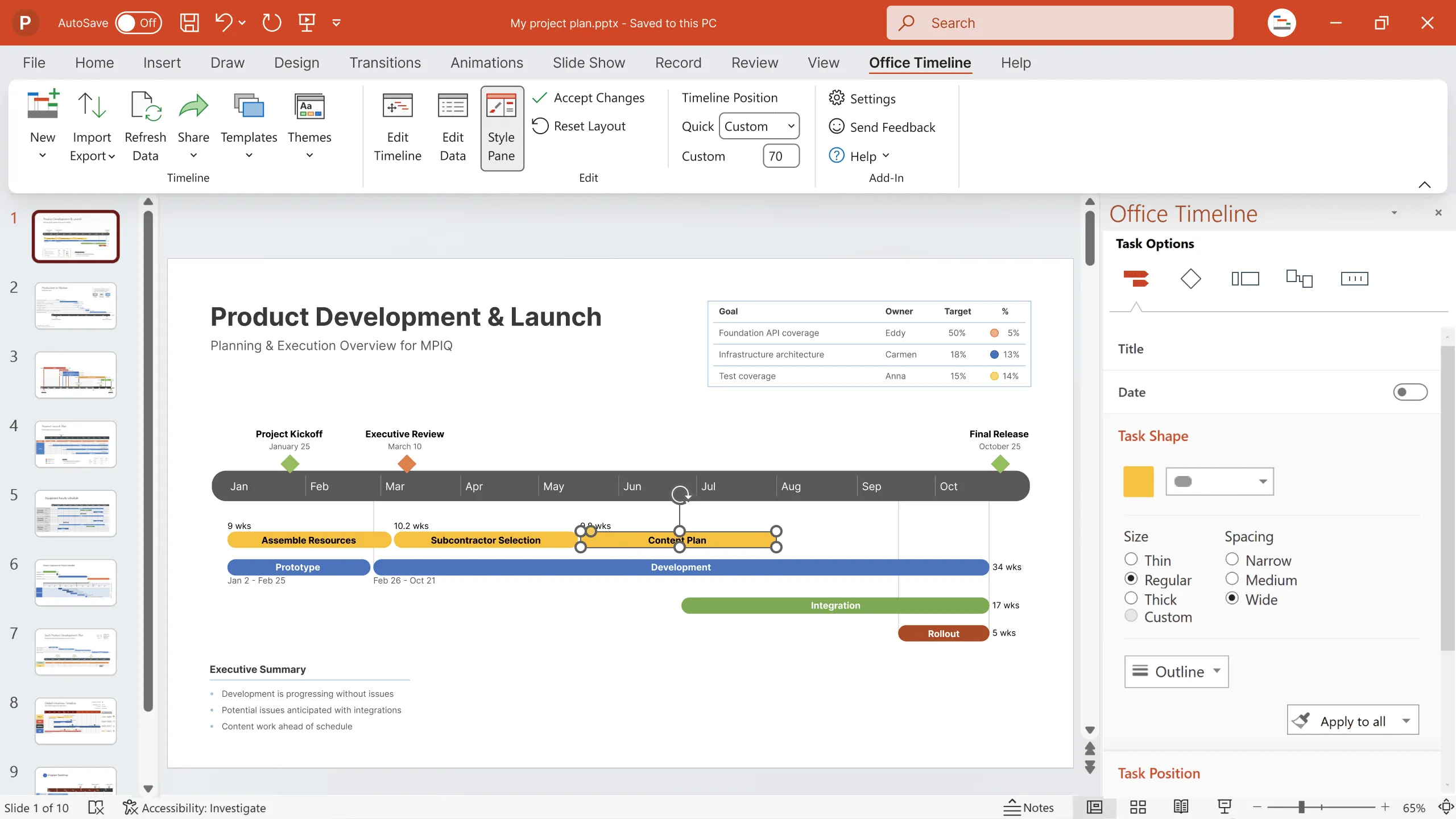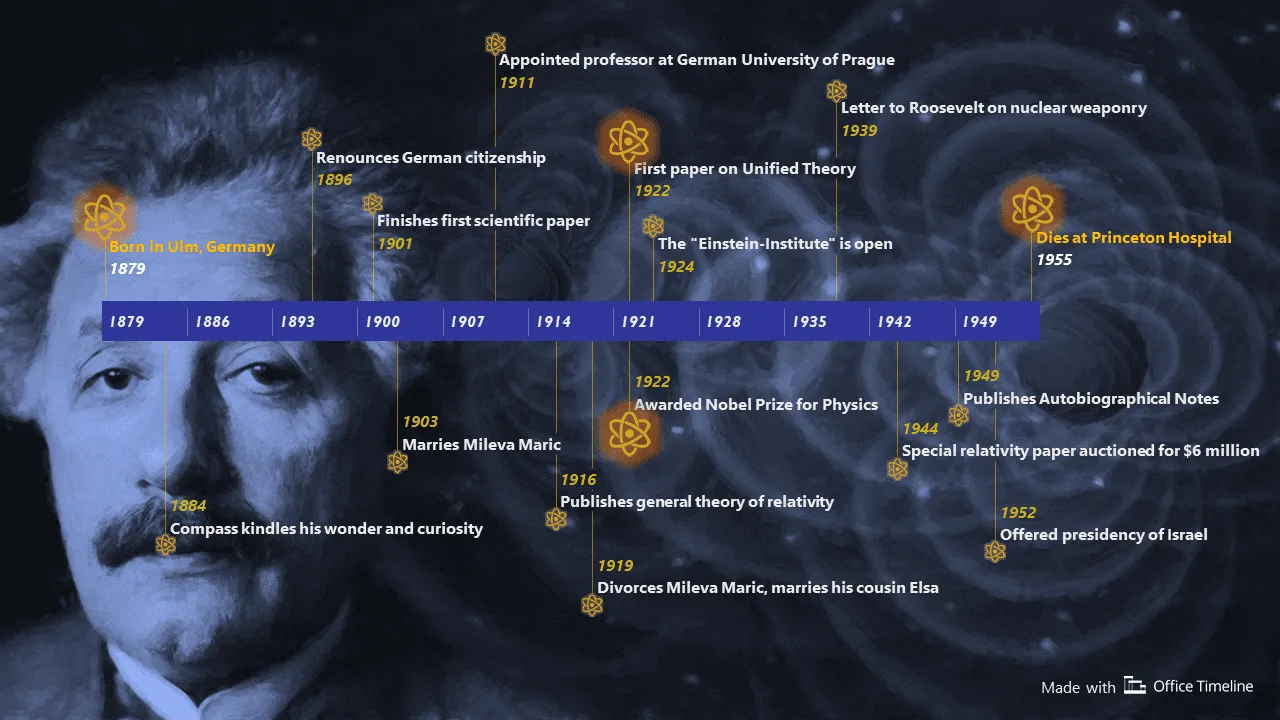Albert Einstein timeline
Join us in celebrating Albert Einstein's birthday on March 14th with a special timeline highlighting his remarkable life and achievements.
Every year on the 14th of March, the world celebrates the most prominent name in modern physics, whose research would lead to the discovery of atomic energy. To mark the birth date of Albert Einstein, we have created a free timeline dedicated to the life and achievements of the famous scientist.
Early life
Born in Ulm, Württemberg, Germany, Albert Einstein was brought up in a secular Jewish family, along with his younger sister Maja. An interesting fact about him is that he didn’t start talking until the age of two. His parents had him undergo several medical examinations, but the doctors were unable to find any physical cause for it. When young Albert eventually began uttering words, his speech was marred by frequent pauses, as though he always paid great care when he spoke.
Einstein’s years were marked by hardships: failed business dealings forced his family to relocate to Switzerland where he was confronted with extremely few career prospects. Disheartened, but not discouraged, he writes: "Life is like riding a bicycle. To keep your balance, you must keep moving."
Fortune does eventually offer Einstein some respite in 1902 when he lands a clerk job at a patent office in Bern, Switzerland’s capital. It is believed that the type of clerical work done there helped him become adept at quickly spotting patterns. It also may have afforded him the time to focus on his research.
Career and scientific achievements
His lucky break comes in 1905 – the “miracle year” – when four major research papers signed by Einstein are published, completely altering the course of modern physics. One of them is “Does the Inertia of a Body Depend Upon Its Energy Content?” from which the special relativity theory and the legendary equation E=mc2 originate.
For anyone else, the achievements of the “miracle year” might have been enough to comfortably ride the glory train towards a smooth, carefree retirement, but not for Einstein. Recognizing a critical flaw in his special relativity theory – the fact that it does not account for acceleration or gravity – he starts working on a new, more comprehensive one. He completes this new theory, called general relativity, in 1915.
What general relativity brings to the table is a new definition of gravity. Unlike Sir Isaac Newton’s model, Einstein’s thesis states that high mass objects warp time and space around them, causing a curvature. Putting advanced mathematics aside, the simplest way to picture it is a person jumping on a trampoline with marbles scattered randomly across its surface. Every descent of the jumper causes a depression in the fabric, drawing all the marbles towards the gap.
Naturally, the scientific community originally regarded it as outlandish and it did take them some time to come around. However, it was another important milestone in Albert Einstein’s ascension to fame that culminated with the position of director of the Kaiser Wilhelm Institute for Physics. He held this role between 1913 and 1933.
Later life and death
His final years were spent almost entirely in isolation in Princeton, the Mecca of scientists at the time. Here, Einstein would continue to work tirelessly on a grand unified field theory where all the laws of physics would fit seamlessly into a single framework. An article published by him in Scientific American in 1950 attempts to map this concept but remains incomplete due to the enigmatic “strong force” that would forever elude him.
Einstein passed away in 1955 from an abdominal aortic aneurysm at the University Medical Center at Princeton, age 76. He declines a surgical intervention, preferring to go on his own terms: "It is tasteless to prolong life artificially. I have done my share, it is time to go. I will do it elegantly”, he reportedly said.
Albert Einstein’s name will forever go down in history as a symbol for creative thinking, dedication, perseverance in the face of overwhelming odds and unflinching integrity.
About the Albert Einstein timeline
The Albert Einstein Timeline was created with the Office Timeline PowerPoint add-in, a powerful and simple to use project management utility able to transform complex data into an appealing visual representation within minutes. Try out the free version or explore the tool's most advanced edition, which packs extra features for those who need more sophisticated applications.
You can download the Albert Einstein timeline for free as a PowerPoint file which contains two slides, a condensed version and a more detailed one.
Have a happy Einstein Day!
Project management tips and tricks
Turn project data into professional timelines
Get the advanced features of Office Timeline free for 14 days.



